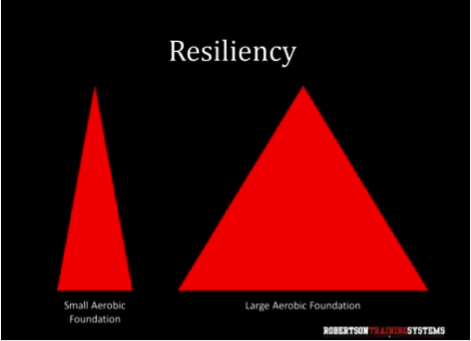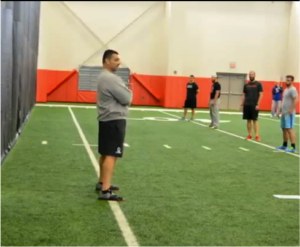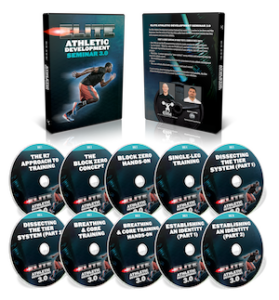
12 Elite Athletic Development Coaching and Programming Lessons
With this week’s release of Mike Robertson and Joe Kenn’s Elite Athletic Development 3.0 DVD set, Cressey Sports Performance coach Nancy Newell and I put our heads together to highlight 12 of the key takeaways from this great new resource.
1. Coaching jump and landing technique is a must.
The “athletic position” occurs in every sport. If you want athletes to apply force, they also need to understand how to absorb force. With ACL injuries on the rise, it’s no surprise that 60-70% of these injuries result from non-contact incidences. This means that kids are getting hurt because they haven’t learned or practiced this technique.
Try these approaches:
a. Deceleration on two legs (Vertical Jump with Stick)
b. Deceleration on one leg (Heiden with Stick)
c. Upper body deceleration (Medicine Ball Work)
2. Don’t count the reps; make the reps count.
It can be challenging for a youth athlete to perform a set of ten bodyweight squats with perfect technique.
[bctt tweet= “Remember: the single-most transferable trait of an excellent program is confidence.”]
If you start to see their form going down the drain, break the reps up into smaller pieces of success. Instead of performing one set of ten reps, you might perform five sets of two reps. The athlete will gain confidence, learn and retain HOW to perform the movement.
3. Teach athletes to “push,” not “pull.”
A common mistake athletes make is having the mentality to “pull” weight off the floor. When we pull weight off the floor, a large portion of that force produced comes from our lower back. If you can teach an athlete to apply force into the ground by “pushing,” a large majority of that force comes from our posterior chain and creates a strong, stable base for our bodies to produce force.
4. Use single leg strength to achieve stability and control, not maximal strength.
While incredibly important, single-leg work is not the best way to get “globally” strong. In a bilateral exercise such as the squat and deadlift, you have a larger base of support to move more weight using mostly prime movers (hamstrings, quads, glutes). A single leg exercise with a smaller base of support places more emphasis on owning and controlling our bodies through multiple planes of motion. Use single-leg exercises to fill in the gaps between maximal strength and stability.

5. Attitude controls your efforts.
One of the most impactful quotes Joe Kenn had during Elite Athletic Development 3.0 was, “You’re not giving good effort with a bad attitude.” Young athletes feed off coaches’ energy, so if you’re upset about something personal that happened and you bring that to the weight room, your athletes will likely adopt that same poor attitude about today.
[bctt tweet=”Your attitude is the number one dictator of the success of your program.”]
You need to have the utmost confidence in yourself to achieve what you set out to complete for each day.
6. Get young athletes proficient in fundamental movements.
This may seem like a no brainer; however, many coaches are willing to place an external load on an athlete before they can confidently control their own bodyweight. Fundamentals are the building blocks for getting stronger, performing better and – most above all – staying injury-free. Youth training should not be about a “quick fix.” It should be about developing efficient motor patterns, skills, and confidence to form a robust foundation for long-term athletic development.
7. “Once relative strength is compromised, continuing to focus on maximal strength becomes an issue.” -Loren Landow
Robertson and Kenn highly urged everyone to over-emphasize general basic strength qualities because strength is a skill. Once you start to “own” this skill, you can start to add layers to challenge your mental and physical strength. Use layering to prepare your athletes for the next phase of training. As an example:
Phase 1: Bodyweight w/3second quasi ISO hold
Phase 2: KB Goblet Squat w/3second lowering/ Explosive concentric
Phase 3: 2KB Squat
8. “There is no elevator to success; you have to take the stairs.”
In your personal life, career, athletics you can’t be afraid to work hard. The most valuable teaching tool is experience, and experience comes from jumping on opportunities to learn from smarter, more experienced people than you. Set your goals high, but don’t jump stairs.

9. Building a more robust athlete comes from the bottom of the pyramid.
If you want to maximize your training results, you have to maximize recovery. One way to kick start recovery is to be consistent with the little things at the bottom of the pyramid (sleep, nutrition, and soft-tissue work). These variables can have a dramatic impact on one’s ability to feel good and stay healthy for the long haul. For example, take an athlete who works out 3x/week for one hour. That’s three hours out of 168 hours in a week. Your training makes up less than 3% of your week, but those “tiny” elements at the base of the pyramid that make up a big chunk of the remaining 97%.
10. An efficient warm up has three broad components:
a. Physiology – We want our athletes to warm-up to increase tissue temperature, improve joint lubrication (especially for the older athletes), and fire up the nervous system.
b. Biomechanics – We aim to optimize alignment; isolate then integrate; and sync up the nervous and musculoskeletal systems.
c. Specific – We want to reflect the actual nature of the activities that follow, whether we’re incorporate lifting weights or training speed/power.
11. High-intensity/anaerobic exercise is built from a low-intensity/aerobic base.
Focusing year-round on just high-intensity work with your athlete will result in a less than impressive work capacity and performance. Instead, use various forms of cardiac output work to expand your pyramid base and help your reach higher anaerobic peaks.

12. Everybody is an athlete.
Regardless of age and training experience, everyone can benefit from training power. Power is vital for overall athleticism, but it is unfortunately one of the first physical qualities we lose as we age. By respecting all the elements on the force-velocity curve you can help anyone get stronger, faster, and more explosive.
Here’s an extended warm-up example that would constitute power training in these individuals:
-Low amplitude/high velocity (jump rope)
-Upper body throw (overhead med ball stomp)
-High amplitude/low(er) velocity (Heidens)
As I noted earlier, Mike Robertson and Joe Kenn’s new Elite Athletic Development 3.0 seminar DVD set is on sale for $100 off through this Friday (7/22) at midnight. I would consider it an outstanding investment for any strength and conditioning professional. For more information, head HERE.
About the Co-Author
Nancy Newell (@NancyNewell2) is a strength and conditioning coach at Cressey Sports Performance in Hudson, MA. Nancy earned her Bachelors Degree in Fitness Development from the State University of New York at Cortland. You can read more from her at www.NancyNewell.com.



